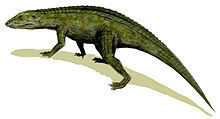Crocodyliformes
| Crocodyliformes Temporal range: Late Triassic–Recent, 225–0 Ma PreЄ Є O S D C P T J K Pg N | |
|---|---|
 | |
Protosuchus, an early crocodyliform | |
Scientific classification | |
| Kingdom: | Animalia |
| Phylum: | Chordata |
| Class: | Reptilia |
| Superorder: | Crocodylomorpha |
Clade: | Crocodyliformes Hay, 1930 |
Clades | |
| |
Crocodyliformes is a clade of crurotarsan archosaurs, the group often traditionally referred to as "crocodilians". They are the only members of Crocodylomorpha who survived beyond the Early Jurassic, while the crocodylomorphs were the only Pseudosuchian group to survive the Triassic–Jurassic extinction event.
In 1988, Michael J. Benton and James M. Clark argued that all traditional names for well-known groups of animals should be restricted to their crown clades, that is, used only for natural groups comprising all living members of any given lineage. This posed a problem for the crocodilians, because the name Crocodylia, while used in various ways by various scientists, had always included not only living crocodilians but many of their extinct ancestors known only from the fossil record.[1]
Benton and Clark's solution to this issue was to restrict the name Crocodylia to the group containing modern alligators, crocodiles, and gharials, plus any extinct members of those specific families. The traditional group "Crocodylia" was replaced by the name Crocodyliformes, which included many of the extinct families that the new definition left out. Clark and Benton did not initially provide an exact definition for Crocodyliformes; but, in 2001, Paul Sereno and colleagues defined it as the clade including Protosuchus richardsoni and the Nile crocodile, plus all descendants of their common ancestor.[2]
Chris Brochu agreed with the assessment that Crocodylia as a name has never had stable contents, and that a series of clades larger than the crown group Crocodylia (including Crocodyliformes and the slightly more inclusive clade Crocodylomorpha) was a good solution.[3] However, in a 2008 paper, Jeremy Martin and Benton reversed the previous opinion (co-authored by Benton) that Crocodylia should be restricted to the crown group, suggesting that Crocodyliformes should be considered a synonym of a more inclusive Crocodylia, and thus replaced.[4] Brochu and colleagues rejected this proposal, arguing that the crown definition of Crocodylia is the standard meaning both within and beyond the crocodyliform systematics community.[5]
Phylogeny
Below is a simplified cladogram based on Fiorelli and Calvo (2007).[6]
.mw-parser-output table.cladeborder-spacing:0;margin:0;font-size:100%;line-height:100%;border-collapse:separate;width:auto.mw-parser-output table.clade table.cladewidth:100%.mw-parser-output table.clade tdborder:0;padding:0;vertical-align:middle;text-align:center.mw-parser-output table.clade td.clade-labelwidth:0.8em;border:0;padding:0 0.2em;vertical-align:bottom;text-align:center.mw-parser-output table.clade td.clade-slabelborder:0;padding:0 0.2em;vertical-align:top;text-align:center.mw-parser-output table.clade td.clade-barvertical-align:middle;text-align:left;padding:0 0.5em.mw-parser-output table.clade td.clade-leafborder:0;padding:0;text-align:left;vertical-align:middle.mw-parser-output table.clade td.clade-leafRborder:0;padding:0;text-align:right
Crocodylomorpha |
| ||||||||||||||||||||||||||||||||||||||||||||||||||||||
| |
In 2012, paleontologists Mario Bronzati, Felipe Chinaglia Montefeltro, and Max C. Langer conducted a broad phylogenetic analysis to produce supertrees of Crocodyliformes, including 184 species. The most parsimonious trees were highly resolved, meaning the phylogenetic relationships found in the analysis were highly likely. Below is a consensus tree from the study:[7]
| |
| |||||||||||||||||||||||||||||||||||||||||||||||||||||||||||||||||||||||||||||||||||||||||||||||||||||||||||||||||||||||||||||||||||||||||||||||||||||||||||||||||||||||||||||||||||||||||||||||||||||||||||||||||||||||||||||||||||||||||||||||||||||||||||||||||||||||||||||||||||||||||||||||||||||||||||||||||||||||||||||||||||||||||||||||||||||||||
| |
References
^ Benton, M.J. and Clark, J.M. (1988). "Archosaur phylogeny and the relationships of the Crocodylia." Pp. 295–338 in Benton, M.J. (ed.), The phylogeny and classification of the Tetrapods, volume 1. Oxford: Clarendon Press.
^ Sereno, P.C., Larson, H.C.E., Sidor, C.A. and Gado, B. (2001). "The giant crocodyliform Sarcosuchus from the Cretaceous of Africa." Science, 294: 1516–1519.
^ Brochu, C.A. (2003). "Phylogenetic approaches toward crocodylian history." Annu. Rev. Earth Planet. Sci., 31: 357–397.
^ Martin, J.E. and Benton, M.J. (2008). "Crown Clades in Vertebrate Nomenclature: Correcting the Definition of Crocodylia." Systematic Biology, 57: 1,173 — 181.
^ Brochu, A.C., Wagner, J.R., Jouve, S., Sumrall, C.D. and Densmore, L.D. (2009). "A correction corrected: consensus over the meaning of Crocodylia and why it matters" Systematic Biology, 58: 537-543.
^ Fiorelli LE, Calvo JO. 2007. The first "protosuchian" (Archosauria: Crocodyliformes) from the Cretaceous (Santonian) of Gondwana. Arquivos do Museu Nacional, Rio de Janeiro 65 (4): 417-459.
^ Bronzati, M.; Montefeltro, F. C.; Langer, M. C. (2012). "A species-level supertree of Crocodyliformes". Historical Biology: 1. doi:10.1080/08912963.2012.662680..mw-parser-output cite.citationfont-style:inherit.mw-parser-output .citation qquotes:"""""""'""'".mw-parser-output .citation .cs1-lock-free abackground:url("//upload.wikimedia.org/wikipedia/commons/thumb/6/65/Lock-green.svg/9px-Lock-green.svg.png")no-repeat;background-position:right .1em center.mw-parser-output .citation .cs1-lock-limited a,.mw-parser-output .citation .cs1-lock-registration abackground:url("//upload.wikimedia.org/wikipedia/commons/thumb/d/d6/Lock-gray-alt-2.svg/9px-Lock-gray-alt-2.svg.png")no-repeat;background-position:right .1em center.mw-parser-output .citation .cs1-lock-subscription abackground:url("//upload.wikimedia.org/wikipedia/commons/thumb/a/aa/Lock-red-alt-2.svg/9px-Lock-red-alt-2.svg.png")no-repeat;background-position:right .1em center.mw-parser-output .cs1-subscription,.mw-parser-output .cs1-registrationcolor:#555.mw-parser-output .cs1-subscription span,.mw-parser-output .cs1-registration spanborder-bottom:1px dotted;cursor:help.mw-parser-output .cs1-ws-icon abackground:url("//upload.wikimedia.org/wikipedia/commons/thumb/4/4c/Wikisource-logo.svg/12px-Wikisource-logo.svg.png")no-repeat;background-position:right .1em center.mw-parser-output code.cs1-codecolor:inherit;background:inherit;border:inherit;padding:inherit.mw-parser-output .cs1-hidden-errordisplay:none;font-size:100%.mw-parser-output .cs1-visible-errorfont-size:100%.mw-parser-output .cs1-maintdisplay:none;color:#33aa33;margin-left:0.3em.mw-parser-output .cs1-subscription,.mw-parser-output .cs1-registration,.mw-parser-output .cs1-formatfont-size:95%.mw-parser-output .cs1-kern-left,.mw-parser-output .cs1-kern-wl-leftpadding-left:0.2em.mw-parser-output .cs1-kern-right,.mw-parser-output .cs1-kern-wl-rightpadding-right:0.2em


